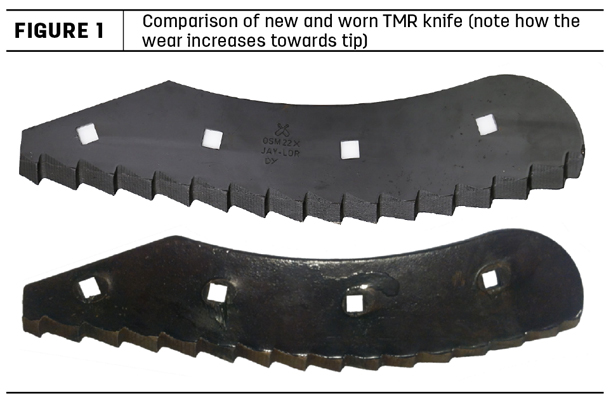Knives should be considered wearable parts of the TMR mixer, especially on dairies that feed baled forage. Knife service life will be dependent on the materials they are made of and the characteristics of the forage that is being processed, not unlike the life of a tire on a vehicle, which is determined by the quality of the tire and how and where it is used.
Factors affecting knife wear
1. Forage fibre
Forage fibre is naturally abrasive and will dull a knife-edge with use over time. This abrasiveness increases with forage maturity (e.g., hay versus straw) and as mineral content increases, especially silica content (e.g., rice straw).
2. Knife location
The upper knives in a mixer are mainly used to cut open intact bales. It is the knives on the lower third of the auger that do up to 80 percent of the cutting and reduction in particle size. This means that the lower knives will usually wear at two to three times the rate of the upper knives, and will need to be replaced more often.
3. Rocks and sand
Rocks and sand from all sources considerably shorten the service life of the knives in a TMR mixer. Rocks are especially bad as they chip the cutting edges when they impact the knives, and then abrasion rounds the areas, making large dull spots. The more rocks that are present, and the bigger they are, the faster the dulling occurs. Increased levels of sand and dirt in forages dramatically increase the abrasive action and the rate of dulling of the knives.
4. Type and quality of knives
There is a wide range of mixer knives available, many of which are specific for certain brands of mixer. In regards to the materials they are made of that affect wear, there are three basic categories: steel, carbide insert and carbide coated.
– Steel: Steel blades are the least expensive, but generally wear at the fastest rate. And though they can be sharpened, it is time-consuming. Thus, they are rarely the most cost-effective choice.
– Carbide inserts: As with saw blades, solid carbide inserts are welded to steel bodies to create carbide insert knives. Carbide is very hard and resistant to abrasion, but is quite brittle and may break fairly easily if rocks are present. Impacts may splinter off very sharp slivers of carbide that can end up in the feed and potentially injure an animal; magnets remove these, as carbide is non-magnetic. Carbide insert knives may be cost-effective, despite being the most expensive, if the feed is generally free of rocks.
– Carbide-coated: Most TMR mixers today use carbide-coated knives. These knives have tiny chips of carbide imbedded in a medium that is bonded to the tapered surface of the cutting edge of a steel knife. As the steel under the layer of carbide coating is worn away, an edge of very sharp carbide chips is exposed. Since the carbide coating is more durable than the steel, a fresh edge is continuously exposed as the steel wears away underneath, making them “self-sharpening.” These knives can be very cost-effective, but also vary greatly in longevity according to the wear characteristics of the carbide coating and steel base. It is recommended that replacement knives be obtained from a reputable supplier and evaluated for their performance characteristics to ensure an optimal return on investment.
Evaluate knife wear
Ultimately, the best way to evaluate knife wear is to first establish how long it takes to process a batch of long forage when the knives are new, and then note how processing times increase with use, either as number of batches made or amount of time elapsed. Then, select an interval at which the increased cost of mixer wear, tractor operation and operator time (labor) warrants replacing the worn knives. These will normally be the knives on the bottom third of the auger, for the reasons discussed above.

It is also useful to periodically inspect the knives on the bottom third of the auger for wear by comparing them with a new knife (see Figure 1). As the knife wears, the width of the coated area near the tip of the knife will decrease. However, to determine sharpness, it is necessary to look at the edge of the knife to determine the degree to which it is rounded. It is this rounding that reduces cutting effectiveness. When this rounding increases and spreads down the length of the knife, it is time for the knife to be replaced, or possibly rotated upward if the wear is not too severe. Experience has shown that replacing half of the knives more frequently improves mixer performance, reduces overall costs and often improves animal performance. ![]()
Alan S. Vaage, Ph.D., is a ruminant nutritionist with Jaylor Fabricating Inc.








